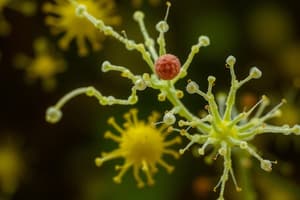Podcast
Questions and Answers
What is taxonomy?
What is taxonomy?
A means by which microorganisms can be grouped together based on similarities.
The 3 fields in taxonomy in order are: ___, ___, ___
The 3 fields in taxonomy in order are: ___, ___, ___
Identification, Classification, Naming
Prokaryote and Eukaryote are not classified in the same group/taxa.
Prokaryote and Eukaryote are not classified in the same group/taxa.
True (A)
Mold (multi-cellular) and Yeast (unicellular) are in the same group.
Mold (multi-cellular) and Yeast (unicellular) are in the same group.
How many methods are there in the phenetic approach?
How many methods are there in the phenetic approach?
What is the natural classification of microorganisms based on?
What is the natural classification of microorganisms based on?
What is the main basis of the phylogenetic method of natural classification?
What is the main basis of the phylogenetic method of natural classification?
What is phenetic classification?
What is phenetic classification?
What are the objectives of phenetic classification?
What are the objectives of phenetic classification?
What is a comparison of phenetic and phylogenetic classification?
What is a comparison of phenetic and phylogenetic classification?
What are the steps in phenetic classification?
What are the steps in phenetic classification?
What is serology?
What is serology?
What is an antigen and give an example?
What is an antigen and give an example?
Who are the four scientists whose classification has been used for the organization of microbes?
Who are the four scientists whose classification has been used for the organization of microbes?
What is a pure culture?
What is a pure culture?
What are the eight branches of the phylogenetic tree of life?
What are the eight branches of the phylogenetic tree of life?
What is the species in the phylogenetic classification?
What is the species in the phylogenetic classification?
What is the genus in the phylogenetic classification?
What is the genus in the phylogenetic classification?
What is the family in the phylogenetic classification?
What is the family in the phylogenetic classification?
What is the order in the phylogenetic classification?
What is the order in the phylogenetic classification?
What is the class in the phylogenetic classification?
What is the class in the phylogenetic classification?
What is the phylum in the phylogenetic classification?
What is the phylum in the phylogenetic classification?
Flashcards are hidden until you start studying
Study Notes
Taxonomy and Microbial Classification
- Taxonomy groups microorganisms based on shared characteristics.
- Identification, classification, and naming are the three fields of taxonomy.
Prokaryotes vs. Eukaryotes
- Prokaryotes and eukaryotes belong to different taxonomic groups.
Mold vs. Yeast
- Molds (multi-cellular) and yeasts (unicellular) are classified in separate groups.
Phenetic Approach
- An old method with seven techniques based on observable traits.
Natural Classification
- Relies on similarities, differences, and evolutionary relationships of organisms.
- Synonymous with the phylogenetic approach, reflecting a taxonomic hierarchy.
Phylogenetic Method
- Focuses on the evolutionary history of organisms.
- Enhanced accuracy through molecular technology.
- Aims to establish natural bacterial classification and understand bacterial evolution.
Phenetic Classification
- Organizes organisms by shared phenotypic traits without considering evolutionary relationships.
- Components include molecular structure, physiology, and habitat.
Objectives of Phenetic Classification
- Identification of unknown organisms for naming purposes.
- Prediction of organism properties based on existing data.
Comparison of Classification Methods
- Phenetic classification prioritizes accurate affinities and practicality; easier to verify.
- Phylogenetic classification focuses on evolutionary relationships; verification is challenging without specific techniques.
Steps in Phenetic Classification
- Collecting and purifying strains.
- Characterizing strains and estimating numerical similarities.
- Arranging strains based on observed relationships.
Serology
- Examines plasma serum to identify antibodies and their quantities.
Antigens
- Substances that trigger antibody production upon introduction to an animal.
- Example: Microbial structures like flagella, capsules, and cell walls can act as antigens.
Key Scientists in Microbial Classification
- Linnaeus: Two-Kingdom Classification (1753) - Animal and Plant Kingdoms.
- Haeckel: Three-Kingdom Classification (1866) - added Protist Kingdom.
- Whittaker: Five Kingdom Classification (1969) - Monera, Protista, Plantae, Animalia, Fungi.
- Woese: Proposed three domains (1977) - Bacteria, Archaea, Eukarya.
Pure Culture
- Derived from a single organism or colony of the same species.
Phylogenetic Tree of Life
- Domains classified hierarchically:
- Domain: Earth
- Kingdom: USA
- Phylum (Division for Bacteria): Arizona
- Class: Maricopa County
- Order: Phoenix
- Family: City within the Valley
- Genus: Street
- Species: Home.
Studying That Suits You
Use AI to generate personalized quizzes and flashcards to suit your learning preferences.



